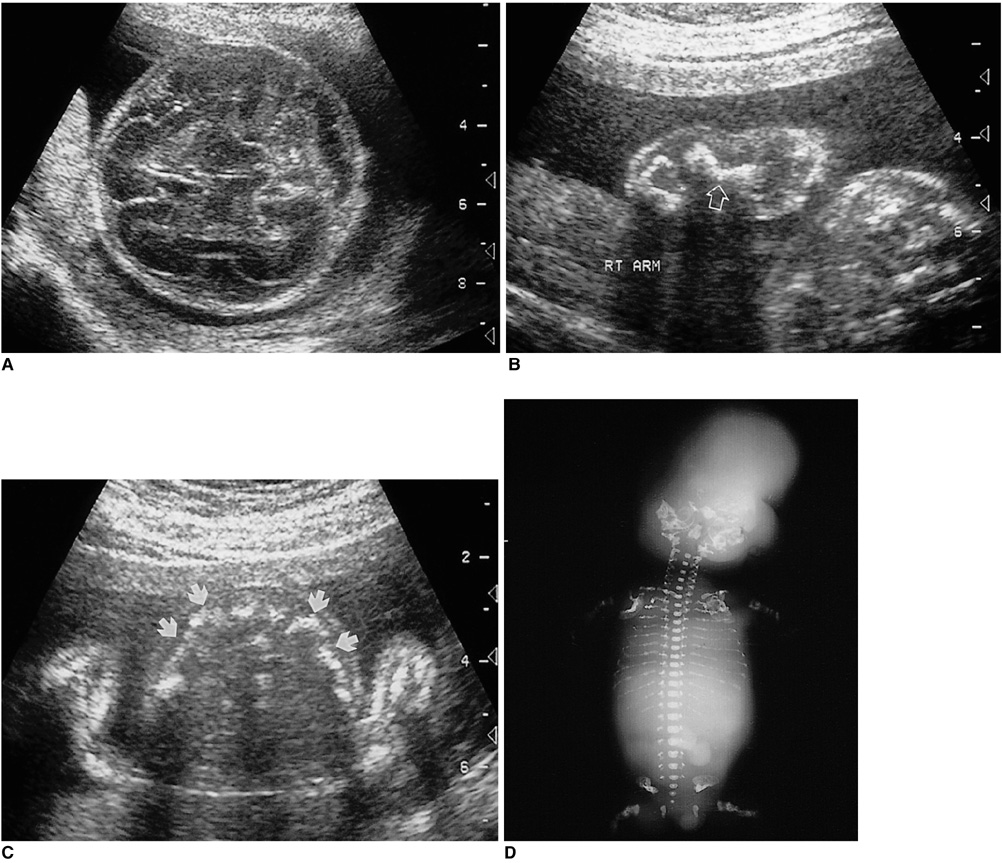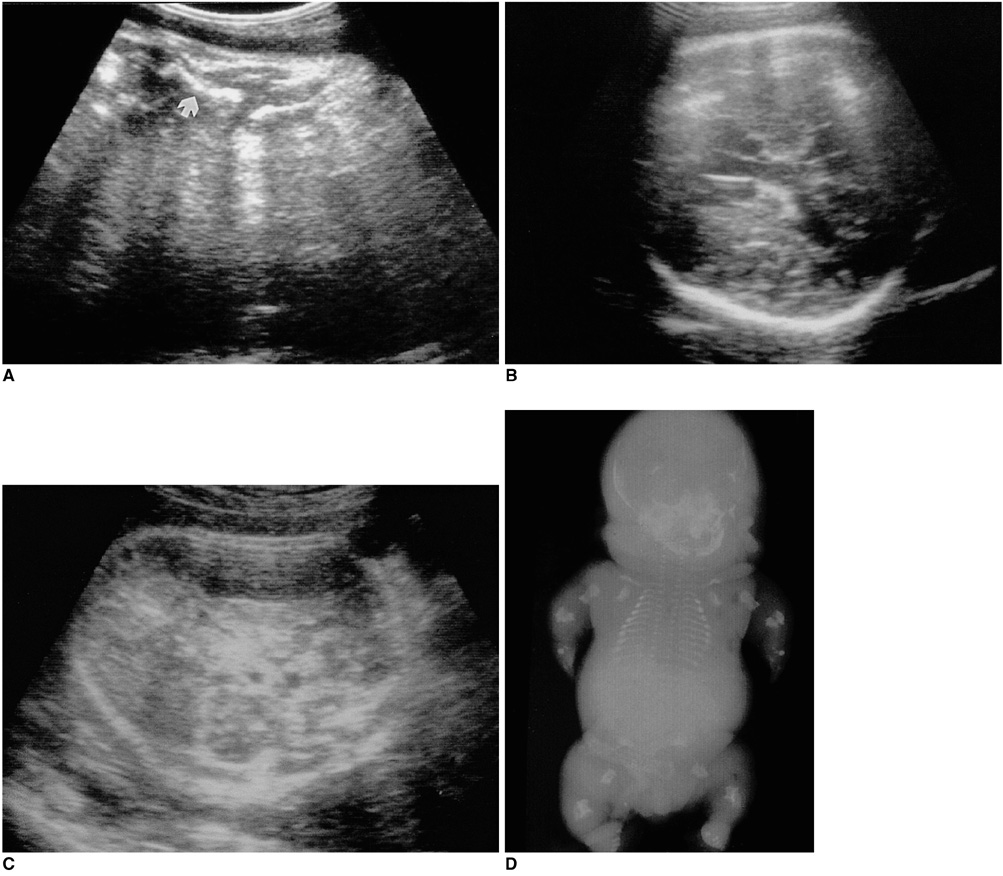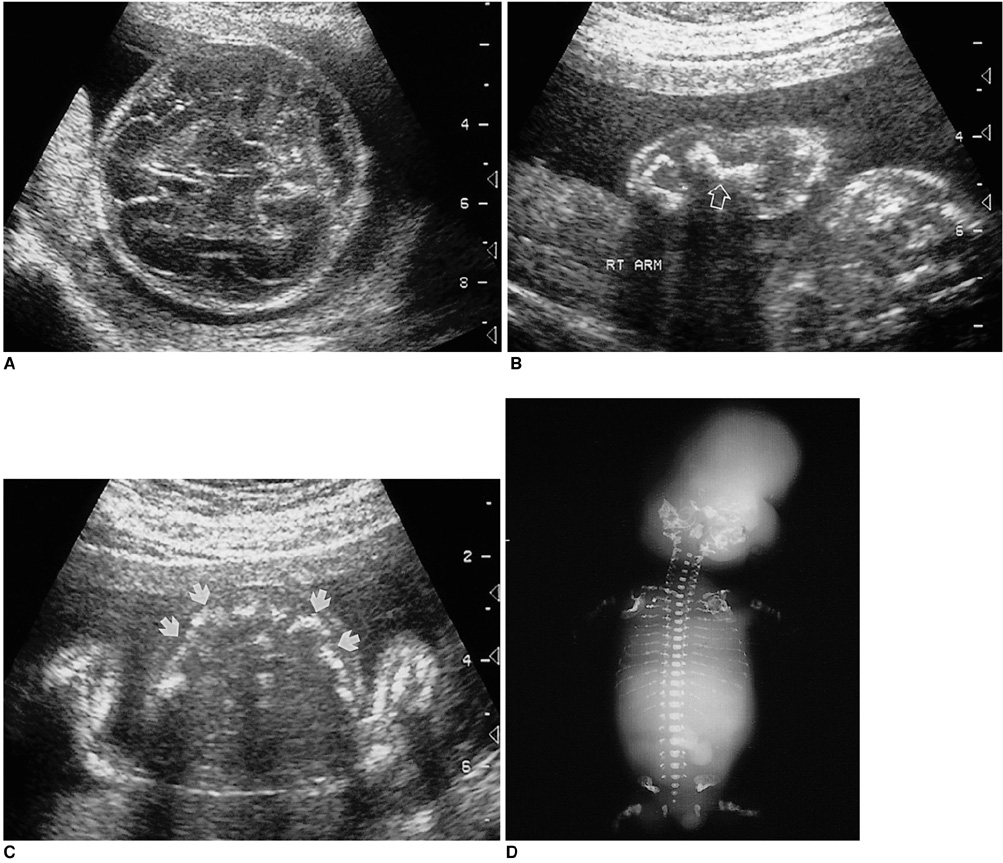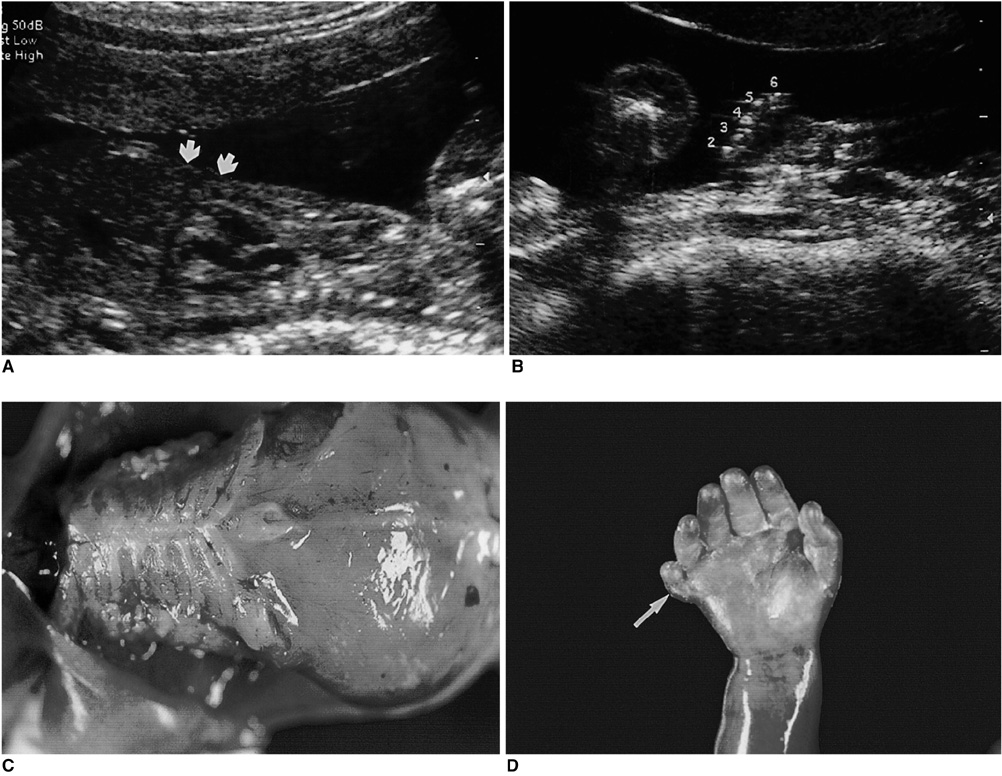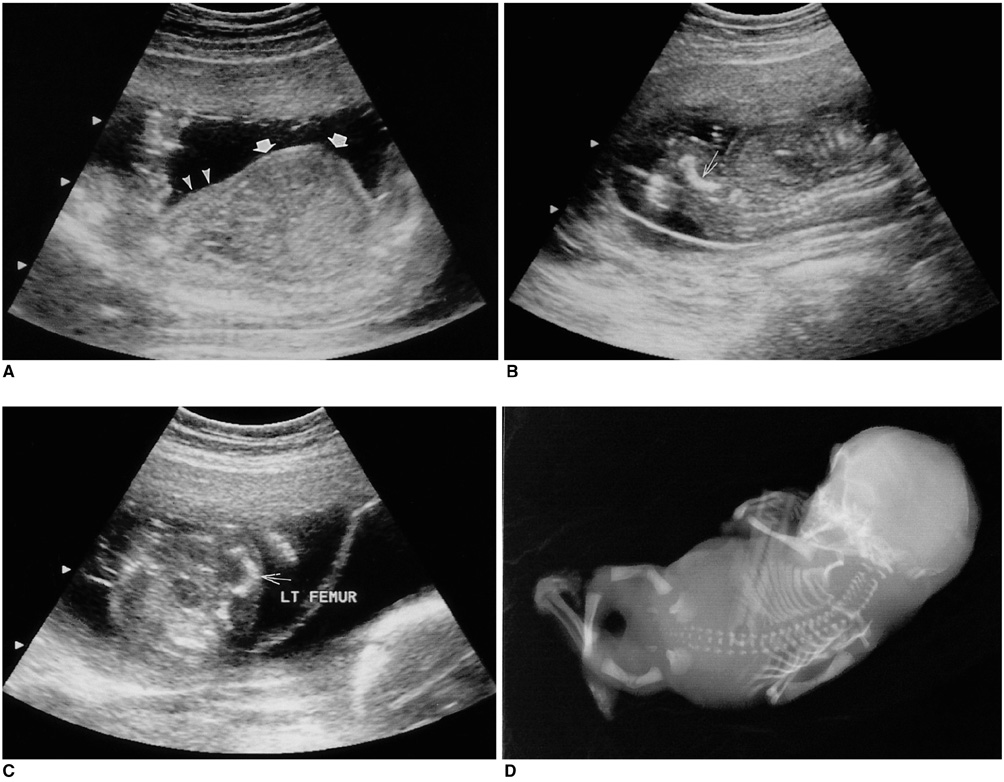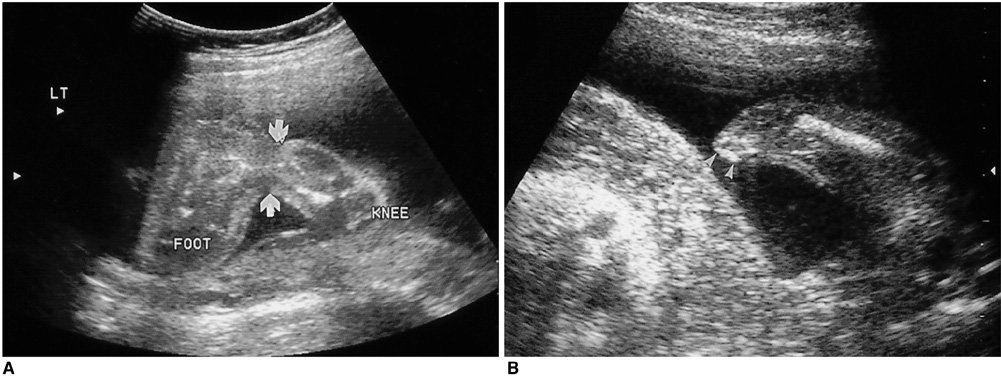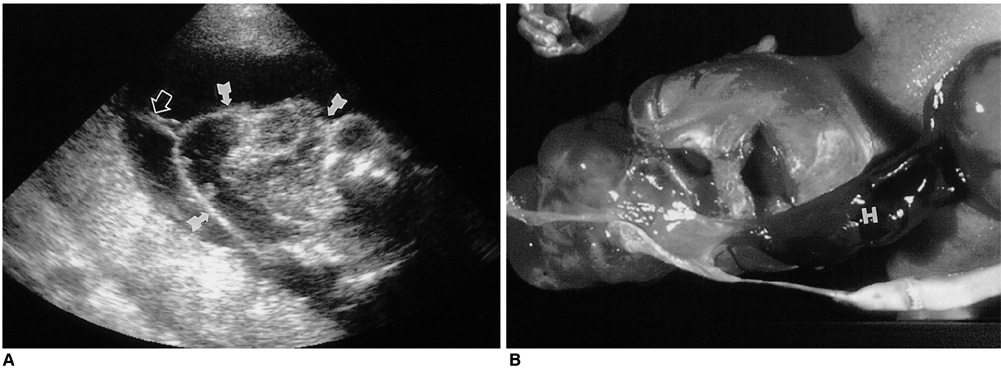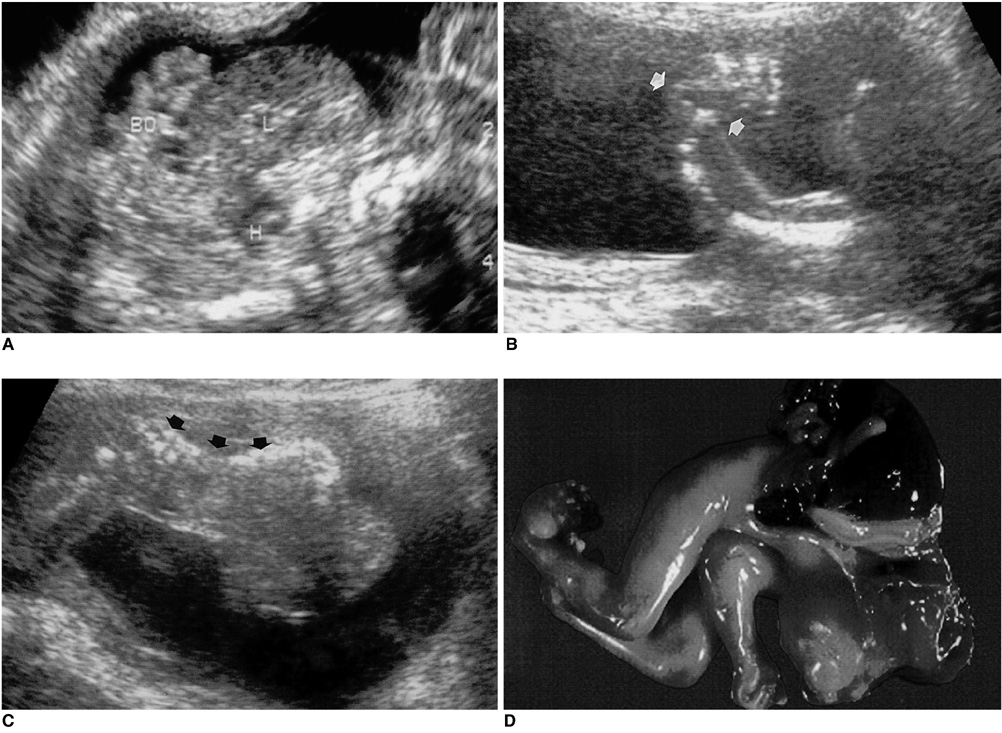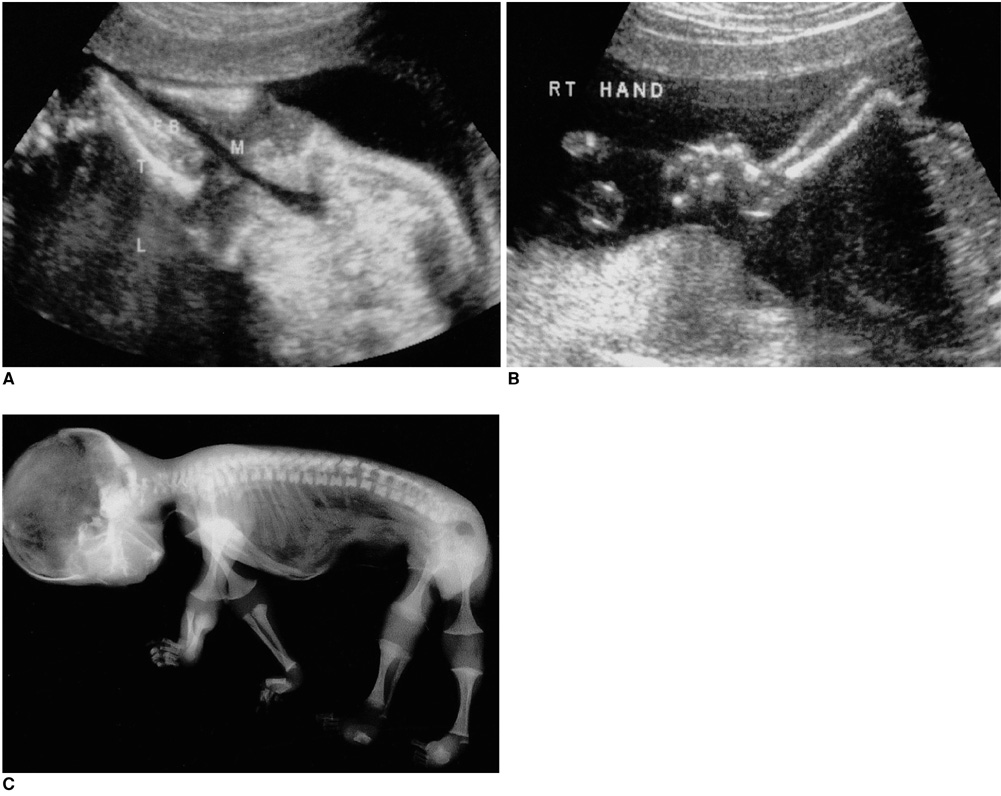Korean J Radiol.
2002 Jun;3(2):113-124. 10.3348/kjr.2002.3.2.113.
Fetal Musculoskeletal Malformations with a Poor Outcome: Ultrasonographic, Pathologic, and Radiographic Findings
- Affiliations
-
- 1Department of Radiology, Samsung Cheil Hospital, Sungkyunkwan University School of Medicine, Seoul, Korea. radjycho@samsung.co.kr
- 2Department of Radiology, Seoul National University College of Medicine, Seoul, Korea.
- KMID: 754070
- DOI: http://doi.org/10.3348/kjr.2002.3.2.113
Abstract
- The early and accurate antenatal diagnosis of fetal musculoskeletal malfomations with a poor outcome has important implications for the management of a pregnancy. Careful ultrasonographic examination of a fetus helps detect such anomalies, and a number of characteristic features may suggest possible differential diagnoses. During the last five years, we have encountered 39 cases of such anomalies, and the typical prenatal ultrasonographic and pathologic findings of a number of those are described in this article.
MeSH Terms
Figure
Reference
-
1. Stoll C, Dott B, Roth MP, Alembik Y. Birth prevalence rates of skeletal dysplasias. Clin Genet. 1989. 35:88–92.2. Maroteaux P, Lamy M, Rober JM. Le nanisme thanatophore. Presse Medicale. 1967. 75:2519–2524.3. Langer LO, Yang SS, Hall JG, et al. Thanatophoric dysplasia and cloverleaf skull. Am J Med Genet. 1987. 3:S. 167–179.4. Lemyre E, Azouz M, Teebi AS, Glanc P, Chen MF. Achondroplasia, hypophosphatasia and thanatophoric dysplasia: review and update. Can Assoc Radiol J. 1999. 50:185–197.5. Sillence DO, Barlow KK, Garber AP, Hall JG, Rimoin DL. Osteogenesis imperfecta type II: delineation of the phenotype with reference to genetic heterogeneity. Am J Med Genet. 1984. 17:407–423.6. Woo JSK, Ghosh A, Liang ST, et al. Ultrasonic evaluation of osteogenesis imperfecta congenita in utero. J Clin Ultrasound. 1983. 11:42–44.7. Whitley CB, Gorlin RJ. Achondrogenesis: new nosology with evidence of genetic heterogeneity. Radiology. 1983. 148:693–698.8. Mahony BS, Filly RA, Cooperberg PL. Antenatal sonographic diagnosis of achondrogenesis. J Ultrasound Med. 1984. 3:333–335.9. Tongsong T, Srisomboon J, Sudasna J. Prenatal diagnosis of Langer-Saldino achondrogenesis. J Clin Ultrasound. 1995. 23:56–58.10. Beighton P, Giedion A, Gorlin R, et al. International classification of osteochondrodysplasias. Eur J Pediatr. 1992. 151:407–415.11. Jones KL. Smith's Recognizable Patterns of Human Malformation. 1997. Philadelpia: Saunders.12. Naumoff P, Young LW, Mazer J, Amortegui AJ. Short rib-polydactyly syndrome type III. Radiology. 1977. 122:443–447.13. Beemer FA, Langer LO Jr, Klepde Pater JM, et al. A new short rib syndrome: report of two cases. Am J Med Genet. 1983. 14:115–128.14. Elejadle BR, de Elejadle MM, Pansch D. Prenatal diagnosis of Jeune syndrome. Am J Med Genet. 1985. 21:433–438.15. Ellis RWB, van Creveld S. A syndrome characterized by ectodermal dysplasia, polydactyly, chondrodysplasia and congenital morbus cordis. Arch Dis Child. 1940. 15:65.16. Cordone M, Lituania M, Zampatti C, et al. In utero ultrasonographic features of camptomelic dysplasia. Prenatal Diagn. 1989. 9:745–750.17. Lazjuk GI, Shved IA, Cherstvoy ED, Feshchenko SP. Camptomelic syndrome: Concepts of the bowing and shortening in the lower limbs. Teratology. 1987. 35:1–8.18. Spranger JW, Opitz JM, Bider U. Heterogeneity of chondrodysplasia punctata. Hum Genet. 1971. 11:190–212.19. Duff P, Harlass FE, Milligan DA. Prenatal diagnosis of chondrodysplasia punctata by sonography. Obstet Gynecol. 1990. 76:497–500.20. Torpin R. Amniochorionic mesoblastic fibrous strings and amniotic bands. Am J Obstet Gynecol. 1965. 91:65–75.21. Higginbottom MC, Jones KL, Hall BD, Smith DW. The amniotic disruption complex: timing of amniotic rupture and variable spectra of consequent defects. J Pediatr. 1979. 95:544–549.22. Burton DJ, Filly RA. Sonographic diagnosis of the amniotic band syndrome. AJR. 1991. 158:555–558.23. Van Allen MI, Curry C, Gallagher L. Limb-body wall complex: I. Pathogenesis. Am J Med Genet. 1987. 28:529–548.24. Balentyne G, Moesinger AC, James LS, Blank WA. Short umbilical cord and multiple anomalies in experimental oligohydramnios. Teratology. 1978. 17:S2. 43A.25. Patten RM, Van Allen M, Mack LA, et al. Limb-body wall complex: In utero sonographic diagnosis of a complicated fetal malformation. AJR. 1986. 146:1019–1024.26. Stevenson RE, Jones KL, Phelan MC, et al. Vascular steal: the pathogenetic mechanism producing sirenomelia and associated defects of the viscera and soft tissues. Pediatrics. 1986. 78:451–457.27. Sirtori M, Ghidini A, Romero R, Hobbins JC. Prenatal diagnosis of sirenomelia. J Ultrasound Med. 1989. 8:83–88.28. Sepulveda W, Romero R, Pryde PG, Wolfe HM, Addis JR, Cotton DB. Prenatal diagnosis of sirenomelus with color Doppler ultrasonography. Am J Obstet Gynecol. 1994. 170:1377–1379.29. Hall JG. Arthrogryposis multiplex congenita: etiology, genetics, classification, diagnostic approach, and general aspects. J Pediatr Orthop B. 1997. 6:159–166.30. Thompson G, Bilenker R. Comprehensive management of arthrogryposis multiplex congenita. Clin Orthop Relat Res. 1985. 194:6–14.31. Kirkinrn P, Herva R, Leisti J. Early prenatal diagnosis of a lethal syndrome of multiple congenital contractures. Prenat Diagn. 1987. 7:189–196.
- Full Text Links
- Actions
-
Cited
- CITED
-
- Close
- Share
- Similar articles
-
- The Usefulness of Ultrasonographic Evaluation in the Musculoskeletal Disease
- Prenatal Diagnosis and Clinical Outcome of Fetal Ovarian Cysts
- The predictive value of abnormal ultrasonographic finding for fetal trisomy in the second trimester
- Prenatal Ultrasound Findings of Fetal Neoplasms
- Ultrasonographic findings of early abortion: suggested predictors


